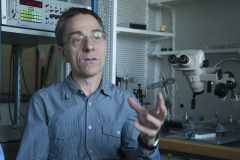Featured Lendület Researcher: Maria Lugaro
Maria Lugaro investigates the circumstances of the birth of stars and planets with the support of MTA’s Lendület (Momentum) Programme. To this end, the astronomer and her colleagues will analyse data obtained by testing stardust in the laboratory.
Maria Lugaro, Senior Research Fellow at the HUN-REN Centre for Astronomy and Earth Sciences, who has been awarded a second grant from the Momentum Programme for her project “Nuclear burning products preserved in meteorites as a tracer of the birth of the Sun and the planets”, has always been fascinated by the rare stardust particles found in meteorites.
 Maria Lugaro Photo: konkoly.hu
Maria Lugaro Photo: konkoly.huThese particles are at most one millionth of the mass of a meteorite, meaning that a kilogram of meteorite contains perhaps a microgram of them. However, through an analysis of them,
the birth of stars and planets can perhaps be revealed
as they contain the “fingerprints” of the nuclear reactions taking place in stars, so, for example, they were also witnesses to the cosmic environment affecting the birth of the Sun. But to do this, we need to find these microscopic pieces of stars.
Needle in a haystack
“It’s not easy to find stardust in meteorites, but in the last thirty years there have been huge advances in the methods of isolating and analysing the material,” says Lugaro. “So we’ve discovered that the chemical structure of these particles is so specific that they are fundamentally different from the material produced by processes in the solar system. It has therefore become clear that this material is not simply from outside the Earth, as it differs from the composition of meteorites in the Solar System, but comes from outside the Solar System.”
This realisation was of huge significance, as it opened up a whole new approach to the study of stars: star researchers could now not only study the light and other radiation emitted by stars, but could also get their hands on a piece of the star itself; and this stardust was already present when the Solar System formed 4.6 billion years ago, although much of it has of course been destroyed in the meantime. However, when asteroids were created, a fraction of these stardust particles became embedded in the material of the celestial bodies, which is why they are still found in meteorites. If the meteorite had not become too hot and had water not entered it over billions of years, it could have preserved the stardust trapped inside it, which has remained analysable up until today.
In the laboratory, the samples taken from the found meteorites are subjected to a rather drastic treatment: they are soaked in acid and heated until only the stardust remains – as stardust is the most resistant and hardest component of meteorites.
“This is the way to find the needle in the haystack. All we have to do is burn all the hay and the needle remains in the ash,”
says Lugaro. “We then put the remains of the meteorite into a mass spectrometer to determine its composition. If we find a composition unknown in the solar system, we have found the stardust.”
In the wake of a star that died billions of years ago
Lugaro is not concerned with the practical isolation of stardust, but rather with the theoretical explanation of the results of mass spectrometry measurements. For example, she and her research team determine which star the analysed sample may have come from, based on the measurements. To do this, they use computer models to virtually recreate the stars on the computer and use algorithms to recreate the nuclear reactions that take place inside the stars. The data obtained by analysing the stardust is then compared with what is known about existing stars. If they are lucky, they will match one of them and then have a good chance of finding the origin of the particles. More specifically, they will have discovered what type of star the dust may have come from.
“The stardust analysed came from a star that had already died and did not exist when the solar system formed. But by comparing its properties with those of stars that still exist today, we can determine the nature of the star that once existed,” says Lugaro. “So by examining stardust, we can obtain evidence of the existence of a star that died billions of years ago. In addition, we can directly study its chemical composition, from which we can extract much more accurate data than if we analysed its light spectrum (which is how we usually study stars that still exist today).”
The astronomer and her colleagues will use different approaches to analyse the data obtained through laboratory analysis of stardust in their Momentum research. Using the composition of the stardust, they will recreate the “stellar neighbourhood” of the formation of the Solar System, simulating what types of stars existed at that time in the surrounding area of the nascent Sun and Solar System, and what properties these stars had;
from this we can find out what factors influenced the birth of the Sun. But they can also infer the evolution of the whole galaxy from the stardust.
The other line of the research is on destroyed stardust. Lugaro says that if a meteorite has melted during the past billions of years, for example, due to some external influence, the stardust it contained was destroyed, and ten to fifteen years ago researchers thought it was lost to science. But today, by examining the remaining material in the meteorite, we are able to find traces of the stardust that was once there.
“It’s like putting sugar in your coffee and then heating it up and stirring it. This makes the sugar seem to disappear, but the coffee becomes sweeter, which suggests that you put sugar in earlier,” says Lugaro, drawing a common analogy for the lasting effect of star dust. “As more and more meteorites are discovered, it turns out that their different properties may be due to the different types of star dust that were previously in them.”












